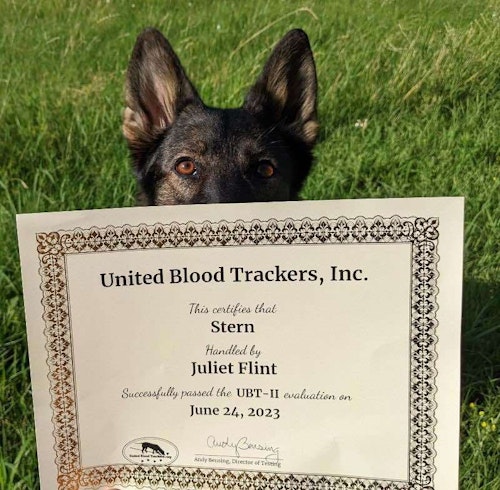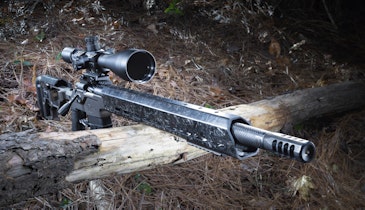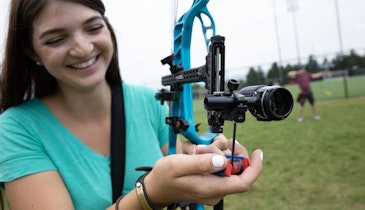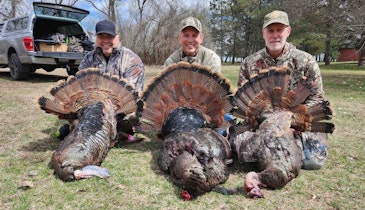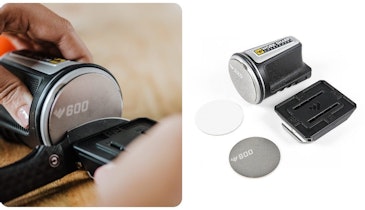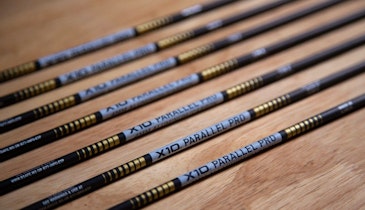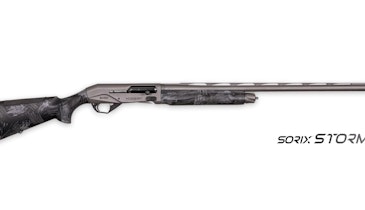I didn’t see the pile of bear scat until I put my hand right in it.
Squinting and muttering some unladylike words, I couldn’t see the dog ahead of me either. My headlamp had given up. We were crawling through the thickest bramble patch on God’s green earth, and I could only feel what the dog was doing through the tension of her lead. This was my telegraph line through the tangle; right then it was telling me that the dog had stopped. Somewhere behind me I heard the hunter curse and the crash of branches. (It’s not a real track if you don’t fall down a few times.)
The dog goes where the bear goes, and the bear is not going where it’s easy for a person to follow.
Holding my breath and wiping my grotty hand in the dirt as I went, I shimmied forward. A few feet ahead, I could just make out the dog’s silhouette. Pointed ears aimed downward, then at me, then down again. She was standing over a hulking mass of black fur. “I think I have a bed here!”
Technically, I did have a bed. The hunter didn’t need to know yet that it was occupied by a very dead bear. At least 100 yards behind us, he was probably reluctant to crawl through that godawful morass of brambles — but this sets the stage for my favorite part.
Letting the hunter see his animal for himself, without me shouting away the surprise while he’s still far behind us, is a trick I learned from trackers who have had boots on the ground for longer than I’ve been alive. It never gets old. I like to ham it up on a difficult track like this, to draw out the suspense.
“The dog seems pretty interested, come take a look!”
The hunter fought his way through the last few branches like a champion boxer, and he looked at the dog and her prize. He looked at me, wide eyed like a kid on Christmas morning. “I’ll be damned. There’s no way I would have found this bear without your dog.”
He reached out to shake my grimy hand, and then wrinkled his nose. We settled for a hug.
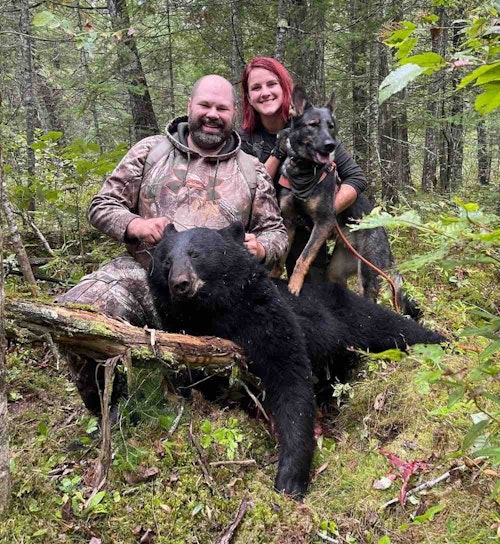
A Woman’s Best Friend
The dog knows more than we do. I would find out later that we had tracked that particular bear almost 800 yards, without a speck of visible blood beyond the hit site. This kind of disappearing act is fairly typical for bears, and it makes a good tracking dog look like magic.
Stern and I have been working together to recover wounded bear and deer for several years now, making sense of tracks that would often otherwise leave hunters empty-handed. Rain or shine, day or night, we bust our tails in pursuit of animals that would rather not be found. There’s no question that Stern would die a happy dog if she never had to take her nose off the ground again — but for the human half of the team, what started as a passing interest has snowballed into a calling.
This particular genre of teamwork is a very old one. Working alongside a dog to track wounded game is an art from the bygone days of stone points and atlatls, and has only recently experienced a revival in the United States. Thanks to the efforts of a few dedicated characters in 1978, the use of leashed tracking dogs in the United States today is an ever growing zeitgeist. More on that later.

Blood-tracking is not for the faint of heart — quite frankly, it calls for a certain level of masochism on the handler’s part. Statistically speaking, the recovery average (that is, the percentage of animals that are found) for leashed tracking dogs in the United States is about 35-40 percent. The reason for this is fairly simple: Most of the animals we are asked to track are not fatally wounded.
Oftentimes, calling in a tracking dog is a hunter’s last Hail Mary after an already marginal shot. Stern and I take every call that we feasibly can, regardless of the shot placement, terrain or weather conditions. In fact, rain and snow are our friend because moisture keeps scent fresh, even when the visible blood has been heavily diluted. When it’s not a successful recovery, she brings peace of mind to hunters who might otherwise feel the quiet dread that they left an animal rotting in the woods.
The Nose Knows
It bears mentioning that the term “blood-tracking dog” is a bit of a misnomer. A trained tracking dog does not actually rely on blood in order to find the target animal. The leading theory among handlers is that the dogs are actually following pheromones: adrenaline, cortisol, invisible “I’m in trouble” signals emitted from a mortally wounded animal.
Most experienced handlers train their dogs using a specially made pair of shoes, and hooves from a deer (photo below). The shoes have slots on the undersides to affix a deer hoof to the bottom of your foot. (This can also be done with bear paws and considerably more duct tape, but most trainers stick to using deer hooves.) From there, a person wearing these shoes can mimic the trail of a wounded animal, depositing scent with each step from the interdigital glands of the deer’s hooves. This is a tried and true method from the old world, where the use of trained dogs for game recovery has undergone all the trial and error of German engineering. Dogs trained using tracking shoes do not skip a beat when the blood trail runs out.
FYI: Trackers like me almost always ask hunters for deer legs after finding their animal. Deer legs are a hot commodity because we can use a pair of hooves only two or three times before they’re spent and no good for training.
Where It All Began
It takes a village to train a tracking dog. I’m a proud member of both United Blood Trackers and Minnesota Tracking Dogs. Both organizations have kept us in the good company of other hardworking tracking dog handlers, and I owe a lot of my know-how to the folks I’ve encountered through my time with these networks.
Most states have their own organized social network of tracking dog handlers. (In my state, this is Minnesota Tracking Dogs.) It is through these social networks that most new handlers will find themselves learning the ropes. The chatrooms and online social media presence of these statewide groups are the stomping grounds of some of the most skilled and knowledgeable tracking dog handlers today.
United Blood Trackers (UBT) is a nationwide organization promoting resource conservation through the use of trained tracking dogs. UBT provides public outreach and hunter education on tracking dogs, as well as formal testing of tracking teams across the country. For hunters in need, the UBT offers a list of available trackers in each state on their website. United Blood Trackers, together with sister organization Deer Search Inc., has propelled the use of leashed tracking dogs into the thriving service that it is today in almost all 50 states.
Beginning in 1978, Deer Search Inc. received the first research permits from New York State to explore the use of leashed tracking dogs for recovering wounded game. The hard work of those first permitted teams paved the way for legislation that has put uncountable numbers of trained dogs on the trail, and in turn, put missing deer and bear on tailgates.
Launched this year, another instrumental tool for connecting hunters and trackers alike is the TRAKR app. TRAKR is an all-in-one game tracking app; when a hunter is in need, they can submit a tracking request through the app and connect with qualified local handlers at the push of a button. This is leaps and bounds ahead of the days of searching around on social media, calling trackers late at night, or trying to remember which buddy may or may not know who to call. Another important detail for hunters is that the tracking teams who are available through TRAKR are proven, so you can rest assured you’re receiving help from a well-trained dog.
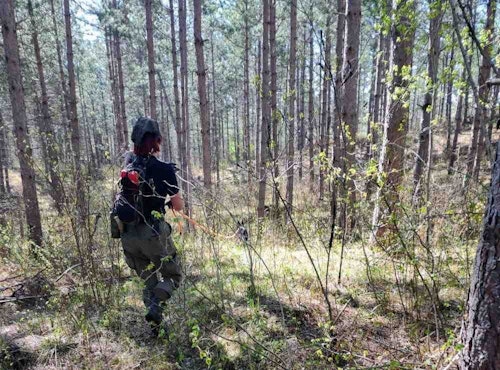
How a Hunter Can Help
There are a few things hunters do (or don’t do) that make an enormous impact on our odds of a successful recovery. Grid searching over the known blood trail is one of the most common and absolute worst things a person can do before calling in a tracking dog. Grid searching, spiraling, or other means of blindly hunting for blood makes it very challenging for the dog to parse out where the animal went.
In the process of a grid search, you may not physically see the animal’s trail, but walking back and forth across that invisible scent line will move the scent far from where the animal actually went. Even the most seasoned dogs may struggle to work this out. Best practice is to avoid grid searching altogether. “When in doubt, back out” is the war cry of tracking dog handlers everywhere. I often tell the hunter that they can grid search to their heart’s content after the tracking dog has come and gone, but the moment you decide to call for a tracking dog, you should stay out of the area until they arrive.
If you are tracking by sight before calling a dog, I recommend walking to one side of the blood trail, and marking the trail clearly with trail tape or toilet paper every so often. If you don’t locate your animal after 200 yards or so, or the trail begins to peter out, back out the same way you came in. This keeps the scent line as neat as possible for the dog.
Wait times are crucial, especially for bucks during the rut. Not only is it dangerous for our dogs to approach a wounded animal, but bumping a live target creates a much bigger headache for both the tracker and the hunter. A gut shot deer can travel for miles if it is tracked too early and bumped out of its bed. Additionally, the farther your animal travels before dying, the higher the odds scavengers will come across the animal before you do.
It may sometimes be frustrating to wait. Remember that trackers see dozens of worst-case scenarios every year, and if you are asked to wait a certain amount of time before tracking your animal, there is a method to the madness. Trackers want to put that critter on your tailgate just as much as you do, but we want to do so safely and efficiently. Sometimes that calls for a lot of patience.
Depending on time of year, your local tracking team could be extremely busy, but we do our best to answer every call and cover as many hunters as we physically can. It may take us a day or more before we’re available to track for you. Most trained dogs can accurately track a wounded animal 48 hours or more after it has been shot. Again, this is a situation where your patience will be rewarded.
Final Thoughts
Alongside the hunters who have heeded these instructions, Stern and I were hard at work in 2023 recovering 20 (out of 60) deer and bears in northern Minnesota. With any luck, we’ll do the same for many more years to come. So if there’s one thing you take from this article, I hope it’s this: We are here to help. Save your local tracker’s number — or download the TRAKR app — as part of the prep work for your next hunt. We hope you won’t need us. But we’re always here if you do.
Sidebar: A Dog Named Stern
A no-nonsense name for a no-nonsense dog, Stern is a 4-year-old female German Shepherd; click here to visit the Facebook page for Stern Game Recovery. She’s a gritty dog with high prey drive and a willingness to work in all conditions, which are important traits for a tracking dog. Stern comes from a long line of military and police detection dogs, and I often tell hunters that she would make a terrible pet — a dog like this was bred to work hard from sunup to sundown, every day.
She and I get along like a house on fire. I chose Stern at 8 weeks old while I was pursuing a different type of scent detection. Not long after, I befriended a local tracking dog handler who set up a training exercise for Stern, and we were both hooked on tracking from there.
Sidebar: Money Matters
It’s best to discuss the cost when you call. That said, most trackers — me included — simply work for tips. The cost of gas, as well as food and vet bills for the dog, and time spent away from our families are topics worth considering when it comes to compensating us for our time, but many trackers will simply tell you that our services cost whatever it is worth to you.
Most, if not all, tracking dog handlers have a full-time day job on top of tracking — as for me, I moonlight (daylight?) as a professional dog trainer. We are sacrificing our limited free time in evenings and weekends to help others recover their game (not to mention the countless hours we spend training and maintaining our dogs in the off-season so we can be ready to roll on opener day.) Your generosity helps keep us on the road and en route to help the next hunter.
The TRAKR app provides information on whether each tracker accepts tips or charges a set fee. I have seen other trackers charge $50-$250 as a set fee for their services.
Photos by Juliet Flint



